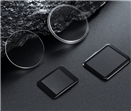

Time:2024-12-04
The development of materials science is one of the important driving forces for technological progress. Among them, sapphire high-strength glass has demonstrated advantages in many high-tech fields due to its performance and stability, becoming an ideal choice to meet the requirements of device stability and reliability. This article will explore the physical properties, application fields, preparation processes, and other aspects of sapphire high-strength glass.
1、 Physical characteristics
Sapphire high-strength glass, also known as synthetic sapphire or aluminum oxide (Al ? O3) crystals, is a single crystal material formed by crystallization of high-purity aluminum oxide at high temperatures. Its notable features include high hardness, wear resistance, excellent transparency, and outstanding chemical stability. Specifically, sapphire glass has a Mohs hardness of up to 9, which makes it excellent in various high wear applications, effectively resisting scratches and wear. Meanwhile, its high transmittance and low dispersion characteristics ensure clarity and authenticity in optical applications, providing users with an excellent visual experience.
In addition, sapphire glass also has a low coefficient of thermal expansion and high thermal conductivity, which means it can maintain dimensional stability over a wide temperature range and effectively dissipate heat, avoiding performance degradation or damage caused by thermal stress. These characteristics enable sapphire glass to maintain excellent performance in extreme environments such as high temperature and high pressure, making it an indispensable material in aerospace, defense, electronics, and other fields.

2、 Wide expansion of application fields
Sapphire high-strength glass has been widely used in various fields due to its properties. Sapphire glass is used as a screen material in consumer electronics fields such as smartphones and tablets. Its high hardness and scratch resistance significantly enhance the durability of devices, reducing damage caused by daily use. At the same time, in the field of watches, sapphire glass has become the choice for watch mirrors due to its unique texture and luster, giving products a higher sense of value.
In the field of optics, sapphire glass is widely used in high-precision camera lenses, telescopes, microscopes and other optical components due to its high transmittance and low dispersion characteristics, providing clear and accurate image quality. In addition, sapphire glass is also used as an observation window and lens in medical equipment and scientific instruments, ensuring clear visibility even in harsh environments.
3、 Preparation process and technical challenges
The preparation process of sapphire high-strength glass is complex and requires high technical requirements. The main preparation methods include Kyropoulos method, chemical vapor deposition (CVD) method, etc. Among them, the Kyropoulos method slowly cools the molten alumina liquid to gradually crystallize and form large-sized single crystal sapphire, but this method is costly and has a long production cycle. The CVD method utilizes gaseous chemical substances to deposit sapphire thin films on substrates, which has higher flexibility and accuracy, and is suitable for manufacturing high-precision optical components and electronic devices.
However, regardless of the preparation method, it faces technical challenges such as raw material purification, crystal growth control, cutting and grinding. Especially the high hardness of sapphire glass requires the use of superhard tools such as diamonds during the processing, which places high demands on the accuracy and stability of the equipment.
Sapphire high-strength glass has shown broad application prospects in multiple fields due to its performance and stability. With the continuous advancement of technology and the expansion of the market, sapphire glass will play a more important role in future technological development.






Tel
Mobile phone
Customer service
TOP